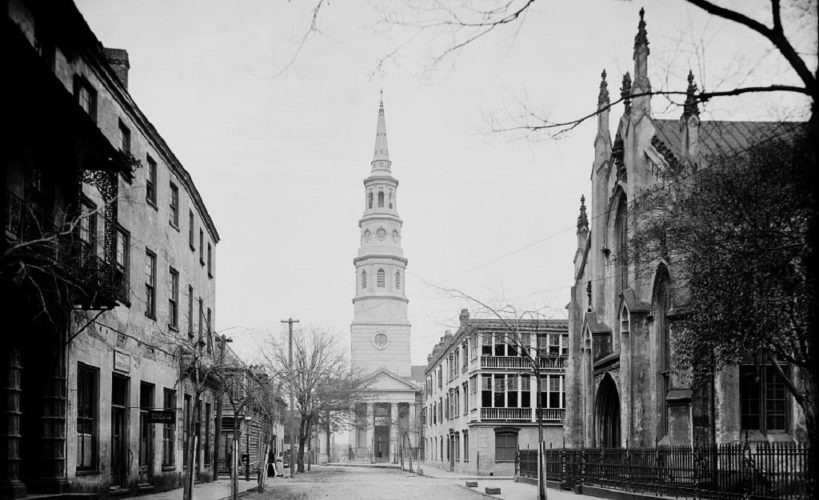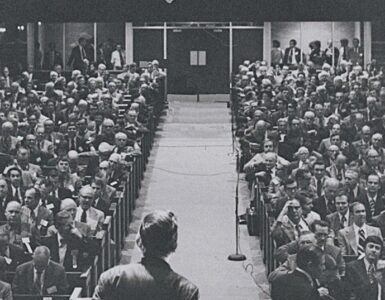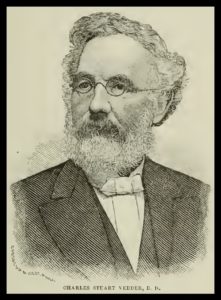 Charles Stuart was born to Albert A. and Susan (Fulton) Vedder in Schenectady, New York, October 7, 1826. His education was provided by Schenectady Lyceum Academy which prepared him to graduate valedictorian of Union College’s class of 1851. Ready for his life’s work, Vedder was employed in the publishing industry by Harpers’ Magazine and other New York periodicals while he anticipated bigger and better things. However, having set his course, his direction would change. Vedder grew up in a Christian home reading the Bible and had been profoundly affected by The Imitation of Christ by Thomas à Kempis (1379-1471). His ancestry was Dutch-German and à Kempis was influenced by the Dutch priest, Geert Groote (1340-1384), whose devotio moderna was a response to what he saw as speculative theology among the Dutch. Groote’s teaching emphasized personal spirituality and taught practical communal religion as applied in the Brethren of the Common Life. But Vedder did not seek the priesthood, rather he became a candidate for the Presbyterian ministry. One thing is certain, he could not have become a priest given his marriage to Helen Amelia (Scovel) of Albany, June 7, 1854.
Charles Stuart was born to Albert A. and Susan (Fulton) Vedder in Schenectady, New York, October 7, 1826. His education was provided by Schenectady Lyceum Academy which prepared him to graduate valedictorian of Union College’s class of 1851. Ready for his life’s work, Vedder was employed in the publishing industry by Harpers’ Magazine and other New York periodicals while he anticipated bigger and better things. However, having set his course, his direction would change. Vedder grew up in a Christian home reading the Bible and had been profoundly affected by The Imitation of Christ by Thomas à Kempis (1379-1471). His ancestry was Dutch-German and à Kempis was influenced by the Dutch priest, Geert Groote (1340-1384), whose devotio moderna was a response to what he saw as speculative theology among the Dutch. Groote’s teaching emphasized personal spirituality and taught practical communal religion as applied in the Brethren of the Common Life. But Vedder did not seek the priesthood, rather he became a candidate for the Presbyterian ministry. One thing is certain, he could not have become a priest given his marriage to Helen Amelia (Scovel) of Albany, June 7, 1854.
Where would the former publisher go for seminary? Since he was about twenty years old he had suffered reoccurring bouts of ill health because of compulsive work habits combined with the difficult climate of long, wet, and cold winters in New York. A more agreeable climate might prove prudent for theological education with the bonus of improved health. Other men that were Presbyterian ministers such as George Howe, Aaron W. Leland, and Zelotes Holmes moved South for warmer winters, so Vedder joined the number by attending Columbia Theological Seminary in South Carolina. He graduated Columbia with twenty others in 1861 just as the Civil War was beginning.
Vedder was soon licensed and ordained by the Presbytery of Charleston for work in First Church, Summerville, beginning 1861. The Summerville congregation could trace its ancestry to a small group of settlers from the Congregational Church in Dorchester, Massachusetts, which sailed in 1695 to Carolina (North and South, divided 1712) to establish a settlement about twenty-two miles northwest of Charleston. The next year they built the Old White Meeting House. At the Synod of South Carolina meeting in 1859 the Presbytery of Charleston reported, “They have organized [June 9, 1859] a Church at Summerville, and constituted the pastoral relation between it and the Rev. A. P. Smith” with one ruling elder, “Arthur Fogartie” (10, 96). After but a year, pastor Andrew Pickens Smith left Summerville to serve the Glebe Street Church in Charleston, 1862, and after a series of brief calls ended his days in First Church, Dallas, Texas, 1873-1895. There are several events and transitions on the timeline between the Old White Meeting House era and organization of the Summerville Presbyterian Church, but the Summerville Presbyterians exemplify the close relationship between Congregationalists and Presbyterians in the Low Country. Both presbyterian and congregational polities held to the Calvinism of the Westminster Confession in opposition to the established religion of the Church of England in the colonial era.
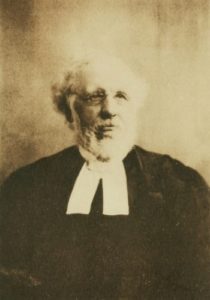 When the Civil War ended in 1865, Vedder continued at Summerville another year before changing call to the Huguenot Church in Charleston where he would be pastor the remainder of his lengthy life. Huguenots fled France and emigrated to other nations in anticipation of Louis XIV’s October 18, 1685 revocation of the Edict of Nantes that had given them some freedoms to practice their Calvinism and worship as Protestants. Just as Congregational churches in South Carolina enjoyed good relationships with the Presbyterians because of their common commitment to the Westminster Confession, so also the Huguenots were friends in ministry with Presbyterians due to their common commitment to Calvinism, rule by elders, and the mercy work of deacons. Consider that W. H. Mills in The Presbyterian Church in South Carolina includes under the category Presbyterian in his listing of the very first ministers to serve churches in South Carolina the Huguenot ministers at Charleston, Elias Prioleau and Florent Philip Trouillart (7). In the minutes of the Synod of South Carolina and those of the Presbyterian Church in the United States General Assembly, Vedder is listed in the statistical table as a minister in Charleston serving the Huguenot Church and the General Assembly’s statistical tables show his call bracketed (thus [Huguenot Church]). By 1900, the Synod discontinued including the name of the Huguenot Church and simply listed him as a pastor residing in Charleston while he continued serving Huguenot. In Presbyterian denominations today ministers accept calls to “labor outside the bounds of presbytery” which means they serve in ministries not under the direct control of a minister’s judicatory. This was Vedder’s situation at the Huguenot Church, but through the decades of his call the comradery of the early days shifts towards a more formal relationship to the Presbytery of Charleston as defined by the Book of Church Order. The rapport among the Presbyterians, Huguenots, and Congregationalists reinforced the Reformed witness in South Carolina particularly during the colonial period when the Church of England was the established church. Unity was found in commitment to Reformed doctrine expressed in confessions.
When the Civil War ended in 1865, Vedder continued at Summerville another year before changing call to the Huguenot Church in Charleston where he would be pastor the remainder of his lengthy life. Huguenots fled France and emigrated to other nations in anticipation of Louis XIV’s October 18, 1685 revocation of the Edict of Nantes that had given them some freedoms to practice their Calvinism and worship as Protestants. Just as Congregational churches in South Carolina enjoyed good relationships with the Presbyterians because of their common commitment to the Westminster Confession, so also the Huguenots were friends in ministry with Presbyterians due to their common commitment to Calvinism, rule by elders, and the mercy work of deacons. Consider that W. H. Mills in The Presbyterian Church in South Carolina includes under the category Presbyterian in his listing of the very first ministers to serve churches in South Carolina the Huguenot ministers at Charleston, Elias Prioleau and Florent Philip Trouillart (7). In the minutes of the Synod of South Carolina and those of the Presbyterian Church in the United States General Assembly, Vedder is listed in the statistical table as a minister in Charleston serving the Huguenot Church and the General Assembly’s statistical tables show his call bracketed (thus [Huguenot Church]). By 1900, the Synod discontinued including the name of the Huguenot Church and simply listed him as a pastor residing in Charleston while he continued serving Huguenot. In Presbyterian denominations today ministers accept calls to “labor outside the bounds of presbytery” which means they serve in ministries not under the direct control of a minister’s judicatory. This was Vedder’s situation at the Huguenot Church, but through the decades of his call the comradery of the early days shifts towards a more formal relationship to the Presbytery of Charleston as defined by the Book of Church Order. The rapport among the Presbyterians, Huguenots, and Congregationalists reinforced the Reformed witness in South Carolina particularly during the colonial period when the Church of England was the established church. Unity was found in commitment to Reformed doctrine expressed in confessions.
One key event in South Carolina history occurred in 1886 when Charleston suffered its greatest natural catastrophe to date. The night of August 31 an earthquake of magnitude 7.3 with its epicenter at Middleton Plantation shook the city with aftershocks occurring for several days. It was felt all over the United States east of the Mississippi, even as far as Canada, Cuba, and Bermuda. It shook lighthouses on the New York shore and may have driven rats out of the city’s sewers. Over five million dollars in damage were caused with about 80 people killed (Peters, 280-81). Pastor Vedder became an important advocate for aide to his own church as well as others when his congregation sent him to New York and other cities seeking funds for repairs to their church. He spoke in New York at Plymouth Church of the Pilgrims, Brooklyn, a Congregational church pastored by Richard S. Storrs. Following Storrs’s introduction, Vedder began his discourse commenting he had not been in Charleston the night of the first quake, but arrived the next day by steam ship. He found his home in ruins, his family in the street, and devastation in every direction. The Huguenot Church needed full reconstruction inside and partial outside with the estimated cost 6,000.00 (New York Tribune, 9/27/1886, p. 1). All the churches, said Vedder, were holding services outdoors with one mass service for the general population held on The Battery each week. He expressed gratitude to the people of New York for the assistance they had already provided adding that he believed their generosity was helping to improve relations between the sections since the Civil War ended (The Brooklyn Union, 10/25/1886 p. 6). He commented that all the churches were damaged sufficiently to exclude them from use for worship.
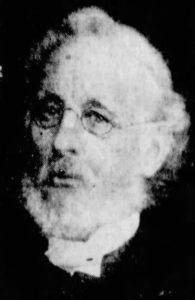 After more than forty years of ministry at Huguenot that included many challenges including times when the congregation could not pay him, he spent his last few years of life as pastor emeritus. One factor contributing to his retirement was total blindness. His final sermon was delivered February 22, 1914. During his life he served outside the church as well as within. Among his other works were serving as a commissioner for the Charleston Public Schools, president of the Charleston Bible Society, president of the City Board of Missions, president of the Training School for Nurses, and the eighth president of the New England Society for 34 years. The New England Society was particularly important to Vedder with its membership paying his rent for an extended time because his congregation could not provide an adequate salary. He was a prominent member of the Huguenot Society and for a quarter of a century president of the Howard Association of Charleston. He was a regular attender and speaker at Chautauqua in New York, and he was a member of the Holland Society of New York. He died in his rented home at 116 Church Street, March 1, 1917, at the age of 91 as the oldest minister in his presbytery as well as the Synod of South Carolina. He had been honored in 1876 by New York University with the Doctor of Divinity, and another D.D. was given to him the next year by the College of Charleston, which in 1895 granted him the Doctor of Laws. His alma mater, Union College, gave him the Doctor of Humanities (no date located). He is buried in the New England Society plot of Magnolia Cemetery next to Helen, who predeceased him June 11, 1915. The Vedders did not have any children.
After more than forty years of ministry at Huguenot that included many challenges including times when the congregation could not pay him, he spent his last few years of life as pastor emeritus. One factor contributing to his retirement was total blindness. His final sermon was delivered February 22, 1914. During his life he served outside the church as well as within. Among his other works were serving as a commissioner for the Charleston Public Schools, president of the Charleston Bible Society, president of the City Board of Missions, president of the Training School for Nurses, and the eighth president of the New England Society for 34 years. The New England Society was particularly important to Vedder with its membership paying his rent for an extended time because his congregation could not provide an adequate salary. He was a prominent member of the Huguenot Society and for a quarter of a century president of the Howard Association of Charleston. He was a regular attender and speaker at Chautauqua in New York, and he was a member of the Holland Society of New York. He died in his rented home at 116 Church Street, March 1, 1917, at the age of 91 as the oldest minister in his presbytery as well as the Synod of South Carolina. He had been honored in 1876 by New York University with the Doctor of Divinity, and another D.D. was given to him the next year by the College of Charleston, which in 1895 granted him the Doctor of Laws. His alma mater, Union College, gave him the Doctor of Humanities (no date located). He is buried in the New England Society plot of Magnolia Cemetery next to Helen, who predeceased him June 11, 1915. The Vedders did not have any children.
Included among Vedder’s works are: “Joy in sorrow”: Remarks at the Funeral of Mrs. Susan Anna Gantt, Charleston: A. E. Miller, & Co., 1864; “Offer unto God Thanksgiving”. A Sermon Delivered in the Summerville Presbyterian Church on Sunday. July 28, 1861, Charleston: Steam-Power Presses of Evans & Cogswell, 1861; Address Delivered at the Annual Commencement of the South Carolina Military Academy, July 8, 1892, Charleston: Walker, Evans, & Cogswell Co., 1892; Sermon Preached in the Huguenot Church, Charleston, S.C., on the Last Day of the Year 1876, with Memorial Notice of the Decease of the Rev. Charles Wallace Howard, Pastor of Said Church, 1845-1852, Charleston: Walker, Evans, & Cogswell, 1877; Address of Rev. Sir Charles S. Vedder, D.D. before South Carolina Commandery No. 1, Knights Templar, at the Huguenot Church, on Ascension Day, May 26, 1881, Charleston: Walker, Evans & Cogswell, 1881; and finally, Centennial Celebration [Charleston Orphan House]. Prayer by Rev. Charles Cotesworth Pinckney … Centennial Oration by the Rev. Charles S. Vedder, Charleston: Walker, Evans & Cogswell Co., 1891—Charleston Orphan House was the first public orphanage established in the United States, 1790, at Wofford College. Several pamphlets and manuscripts are available at the South Carolina Historical Society, Charleston, and in Special Collections of the College of Charleston. An interesting item at the South Caroliniana Library, University of South Carolina, Columbia, is Vedder’s three-volume manuscript journal 1861-1866 available at, https://digital.tcl.sc.edu/digital/collection/vedder/search.
Barry Waugh
Notes—The header is cropped and enhanced from the Library of Congress Online Digital Collection image titled, “[French Huguenot Church and St. Philip’s Church, Charleston, S.C.],” which is believed to date to between 1910 and 1915. The building on the immediate right is Huguenot Church and the church at center is St. Philips Episcopal. The building currently between the two churches on the right appears to be the same one as in the header, and the two buildings on the left across from Huguenot Church in the header appear to be the same ones today.
For biographical information sources examined include: “Charles Stuart Vedder,” in Men of Mark in South Carolina; Ideals of American Life: A Collection of Biographies of Leading Men of the State, vol. 1, ed. J. C. Hemphill, Washington: Men of Mark Publishing Co., 1907; History of the New England Society of Charleston, South Carolina, for One Hundred Years, 1819-1919, Charleston: By the Society, 1920, also provided the sepia colored portrait; the memorial by Alexander Sprunt for Vedder in, Minutes of the Synod of South Carolina, 1917. Huguenot and biographical material are in: The French Protestant Church in the City of Charleston “The Huguenot Church, A Brief History of the Church and Two Addresses Delivered on the Two Hundred and Twenty-Fifth Anniversary of the Founding of the Church, April 14, 1912,” Charleston: Walker, Evans & Cogswell, 1912. Vedder is said to have graduated seminary in 1862 in Memorial Volume of the Semi-Centennial of the Theological Seminary at Columbia, South Carolina, 1884, pages x, 384, 431, but other sources say 1861. For his college information see, Union College, 1795-1895; A Record of the Commemoration, June Twenty-First to the Twenty-Seventh, 1895, of the One Hundredth Anniversary of the Founding of Union College, Including a Sketch of its History, 1897.
Information about the earthquake attributed to Peters refers to Kenneth E. Peters two articles, “Earthquake rods” and “Earthquakes” in Walter Edgar, editor, The South Carolina Encyclopedia, The University of South Carolina Press, 2006; interestingly, earthquake rods were already installed in Charleston buildings but not for earthquakes, hurricanes instead.
Obituaries for Vedder can be found in: The Asheville Times, March 5, 1917, Monday, page 8; The Charlotte News, March 16, 1917, Friday, page 5; The State (Columbia), March 2, 1917, Friday, page 1, and the funeral, March 3, 1917, Saturday, page 6, Friday, pages 1, 3; The Presbyterian of the South, March 14, 1917, Wednesday, page 26; The Watchman and Southron (Sumter), Mar 7, 1917, Wednesday, page 6; The Union Times (Union), March 9, 1917, Friday, page 1; The Columbia Record, March 1, 1917, Thursday, page 10; The Beaufort Gazette, March 9, 1917, Friday, page 6; Aiken Standard, March 7, 1917, Wednesday, page 8; The Atlanta Constitution, March 2, 1917, Friday, page 14; The Macon Telegraph, March 2, 1917, Friday, page 9. All of these obituaries provide similar information.


